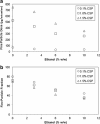Advances in metered dose inhaler technology: formulation development
- PMID: 24452499
- PMCID: PMC3969484
- DOI: 10.1208/s12249-013-0063-x
Advances in metered dose inhaler technology: formulation development
Abstract
Pressurized metered dose inhalers (MDIs) are a long-standing method to treat diseases of the lung, such as asthma and chronic obstructive pulmonary disease. MDIs rely on the driving force of the propellant, which comprises the bulk of the MDI formulation, to atomize droplets containing drug and excipients, which ideally should deposit in the lungs. During the phase out of chlorofluorocarbon propellants and the introduction of more environmentally friendly hydrofluoroalkane propellants, many improvements were made to the methods of formulating for MDI drug delivery along with a greater understanding of formulation variables on product performance. This review presents a survey of challenges associated with formulating MDIs as solution or suspension products with one or more drugs, while considering the physicochemical properties of various excipients and how the addition of these excipients may impact overall product performance of the MDI. Propellants, volatile and nonvolatile cosolvents, surfactants, polymers, suspension stabilizers, and bulking agents are among the variety of excipients discussed in this review article. Furthermore, other formulation approaches, such as engineered excipient and drug-excipient particles, to deliver multiple drugs from a single MDI are also evaluated.
Figures







References
-
- Thiel CG. From Susie's question to CFC free: an inventor's perspective on forty years of MDI development and regulation. Respir Drug Deliv. 1996;1:115–24.
-
- Evans M, Telfer A, Smith R, Smith B, Lang G, Chen J, et al. Stratospheric sink for chlorofluoromethanes: chlorine atomc-atalysed destruction of ozone. Nature. 1974;249:811.
-
- McDonald KJ, Martin GP. Transition to CFC-free metered dose inhalers—into the new millennium. Int J Pharm. 2000;201(1):89–107. - PubMed
-
- Newman SP, Peart J. Pressurized metered dose inhalers. In: Newman SP, editor. Respiratory drug delivery: essential theory and practice. Richmond: Respiratory Drug Delivery Online; 2009. pp. 117–216.
Publication types
MeSH terms
LinkOut - more resources
Full Text Sources
Other Literature Sources

